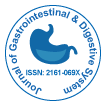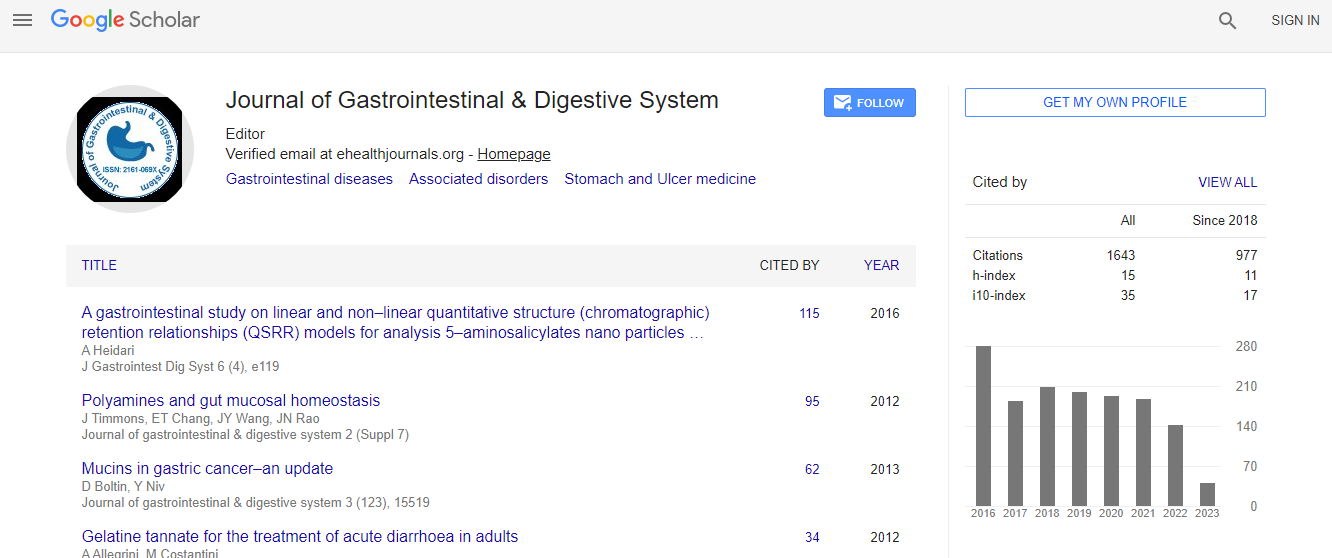Our Group organises 3000+ Global Conferenceseries Events every year across USA, Europe & Asia with support from 1000 more scientific Societies and Publishes 700+ Open Access Journals which contains over 50000 eminent personalities, reputed scientists as editorial board members.
Open Access Journals gaining more Readers and Citations
700 Journals and 15,000,000 Readers Each Journal is getting 25,000+ Readers
Google Scholar citation report
Citations : 2091
Journal of Gastrointestinal & Digestive System received 2091 citations as per Google Scholar report
Journal of Gastrointestinal & Digestive System peer review process verified at publons
Indexed In
- Index Copernicus
- Google Scholar
- Sherpa Romeo
- Open J Gate
- Genamics JournalSeek
- China National Knowledge Infrastructure (CNKI)
- Electronic Journals Library
- RefSeek
- Hamdard University
- EBSCO A-Z
- OCLC- WorldCat
- SWB online catalog
- Virtual Library of Biology (vifabio)
- Publons
- Geneva Foundation for Medical Education and Research
- Euro Pub
- ICMJE
Useful Links
Recommended Journals
Related Subjects
Share This Page
Inositol trisphosphate receptor, type 3 (InsP3R3) is regulated by microRNA-506 (miR-506) which is upregulated in primary biliary cirrhosis (PBC)
International Conference and Exhibition on Gastrointestinal Therapeutics
M Ananthanarayanan
Yale University, USA
Posters-Accepted Abstracts: J Gastrointest Dig Syst
Abstract
The type III isoform of the inositol 1,4,5-trisphosphate receptor (InsP3R3) is apically localized and triggers Ca2+ waves and secretion in a number of polarized epithelia. However, nothing is known about epigenetic regulation of this InsP3R isoform. We investigated miRNA regulation of InsP3R3 in primary bile duct epithelia (cholangiocytes) and in the H69 cholangiocyte cell line, because the role of InsP3R3 in cholangiocyte Ca2+ signaling and secretion is well established and because loss of InsP3R3 from cholangiocytes is responsible for the impairment in bile secretion that occurs in a number of liver diseases. Analysis of the 3ΓΆΒ?Β?- UTR of human InsP3R3 mRNA revealed two highly conserved binding sites for miR-506. Transfection of miR-506 mimics into cell lines expressing InsP3R3-3ΓΆΒ?Β?UTR-luciferase led to decreased reporter activity, while co-transfection with miR-506 inhibitors led to enhanced activity. Reporter activity was abrogated in isolated mutant proximal or distal miR-506 constructs in miR-506 transfected HEK293 cells. InsP3R3 protein levels were decreased by miR-506 mimics and increased by inhibitors, and InsP3R3 expression was markedly decreased in H69 cells stably transfected with miR506 relative to control cells. miR506-H69 cells exhibited a fibrotic signature. In situ hybridization revealed elevated miR506 expression in vivo in human diseased cholangiocytes. Histamine-induced, InsP3-mediated Ca2+ signals were decreased by 50% in stable-miR-506 cells compared to controls. Finally, InsP3R3-mediated fluid secretion was significantly decreased in isolated bile duct units (IBDU) transfected with miR-506, relative to control IBDU. Together, these data identify miR-506 as a regulator of InsP3R3 expression and of InsP3R3-mediated Ca2+ signaling and secretion.Biography
Email: ananth.meena@yale.edu

 Spanish
Spanish  Chinese
Chinese  Russian
Russian  German
German  French
French  Japanese
Japanese  Portuguese
Portuguese  Hindi
Hindi 
